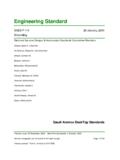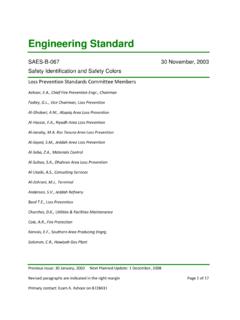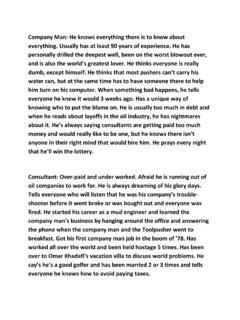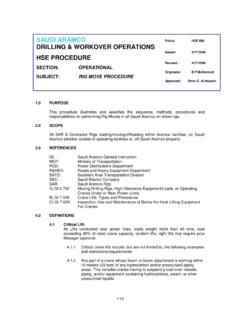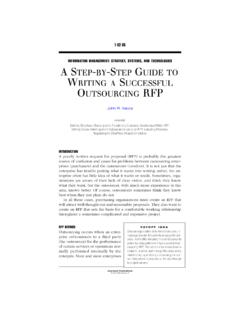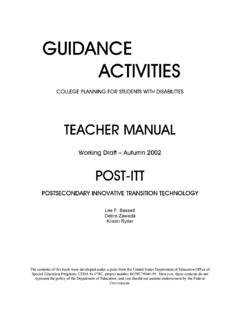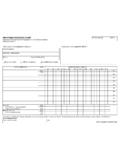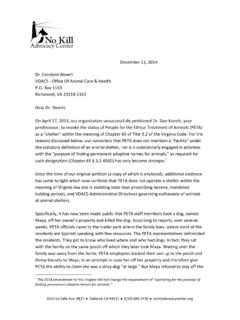Transcription of 1997 Drillers Stuck pipe Handbook - Oil Field Trash
1 1997 DrillersStuck pipe Handbook1997 Guidelines & Drillers Handbook Creditswritten byColin Bowes & Ray Procterwith graphics bySedco ForexProject Steering & Review TeamDave RingroseDick LancasterKeith CoghillDave RobertsEarl Scott - Sedco ForexMultimedia CD Created and Published byProcter & Collins LtdBallater, Scotland, AB35 5 STICKING MECHANISMS STICKING MECHANISM SOLIDS INDUCED PACKING OFF - FIRST UNCONSOLIDATED MOBILE FRACTURED & FAULTED NATURALLY OVER-PRESSURED SHALE INDUCED OVER-PRESSURED SHALE REACTIVE HOLE TECTONICALLY STRESSED DIFFERENTIAL MECHANICAL & WELL BORE OTHER Stuck pipe TYPES - FIRST KEY UNDERGAUGE LEDGES AND COLLAPSED CASING / CEMENT GREEN CEMENT222. TECHNICAL ISSUES HOLE MONITORING CUTTINGS RETURNS AT THE HOLE GENERAL FACTORS EFFECTING HOLE RIG SITE VERTICAL AND NEAR VERTICAL HIGH ANGLE, EXTENDED-REACH WELLS263.
2 BEST PRACTICE PREVENTION OF Stuck pipe DURING ROUTINE REAMING & BACKREAMING TRIPPING - DEVIATED CONNECTION SURVEYING -- Stuck pipe AVOIDANCE WHILE CASING & WELL LOST AIR/FOAM DRILLING WITH COILED PREVENTING DRILL STRING FAILURES - A CAUSE OF Stuck CARE OF SECONDARY FREEING FREEING pipe RELEASE AGENTS (PRA) FRESH WATER FREE POINT INDICATORS (FPI) INFORMATION REQUIRED BEFORE FREEING OPERATIONS START494. JARS & ACCELERATORS GENERAL COMMENTS ON THE SUCCESSFUL USE OF FORCES REQUIRED TO FIRE PUMP OPEN JAR WEIR BOWEN COUGAR & DAILEY PROPER HANDLING OF SMALL DRILLING / FISHING JARS (DAILEY) DELIVERY TO PICKING UP AND LAYING DOWN OF STAND BACK PROCEDURES FOR DRILLING/FISHING JARS (DAILEY) ROUTINE MAINTENANCE OF DRILLING/FISHING JARS IN THE ACCELERATOR JAR AND ACCELERATOR GUIDELINES FOR USE OF JARS IN VERTICAL GUIDELINES FOR USE OF JARS IN DEVIATED & HORIZONTAL WELLS645.
3 COMMUNICATION REPORTING656. APPENDICES Stuck pipe INCIDENT pipe STRETCH CALCULATION TORQUE AND PULL CALCULATION JARRING CALCULATION FORMULAESTICKING Mechanism Induced Off - First Actionsa)At the first signs of the drill string torquing up and trying to pack-off, the pump strokes should be reduced by half. This willminimise pressure trapped should the hole pack-off. Excessive pressure applied to a pack-off will aggravate the situation. If thehole cleans up, return flow to the normal )If the string packs off, immediately stop the pumps and bleed down the standpipe pressure [NB not possible with a non-portedfloat valve].
4 When bleeding pressure down from under a pack-off, control the rate so as not to "U" tube solids into the drillstring in case they plug the )Leave low pressure (<500 psi ) trapped below the pack-off. This will act as an indicator that the situation is improving shouldthe pressure bleed )Holding a maximum of 500 psi on the standpipe and with the string hanging at its free rotating weight, start cycling the drillstring up to maximum make-up torque. At this stage do not work the string up or )Continue cycling the torque, watching for pressure bleed off and returns at the shakers. If bleed off or partial circulation occurs,slowly increase pump strokes to maintain a maximum of 500 psi standpipe pressure. If circulation improves continue to increasethe pump )If circulation cannot be regained, work the pipe between free up and free down weight. DO NOT APPLY EXCESSIVE PULLSAND SET DOWN WEIGHTS AS THIS WILL AGGRAVATE THE SITUATION (50k lb max).
5 Whilst working the stringcontinue to cycle the torque to stall out and maintain a maximum of 500 psi standpipe )DO NOT ATTEMPT TO FIRE THE JARS IN EITHER )If circulation cannot be established increase the standpipe pressure in stages up to 1500 psi and continue to work the pipe andapply )If the pipe is not free once full circulation is established, commence jarring operations in the opposite direction to thelast pipe movement. Once the pipe is free rotate and clean the hole prior to continuing the unconsolidated formation falls into the well bore because it is loosely packedwith little or no bonding between particles, pebbles or clip of sand sloughingThe collapse of the formation is caused by removing the supporting rock as thewell is drilled. This is very similar to digging a hole in sand on the beach, thefaster you dig the faster the hole happens in a well bore when little or no filter cake is present.
6 The un-bondedformation (sand, gravel, small river bed boulders etc.) cannot be supported byhydrostatic overbalance as the fluid simply flows into the formation. Sand orgravel then falls into the hole and packs off the drill string. The effect can be agradual increase in drag over a number of metres, or can be mechanism is normally associated with shallow formations. Examples areshallow river bed structures at about 500m in the central North Sea and insurface hole sections of land mechanism normally occurs: While drilling shallow unconsolidated ActionThese formations need an adequate filter cake to help stabilise the loss can be minimised with fine lost circulation material. If possible,avoid excessive circulating time with the BHA opposite unconsolidated formations to reduce hydraulic erosion. Spot a gelpill before POOH. Slow down tripping speed when the BHA is opposite unconsolidated formations to avoid and stop the pumps slowly to avoid pressure surges being applied to unconsolidated formations.
7 Control-drill thesuspected zone to allow time for the filter cake to build up, minimise annulus loading and resultant ECD s. Use sweeps tohelp keep the hole clean. Be prepared for shaker, desilter and desander method successfully used in the North Sea is to drill 10m, pull back to the top of the section and wait 10 minutes. Noteany fill on bottom when returning to drill ahead. If the fill is significant then ensure the process is repeated every 10m. Itmay be impossible to prevent the hole collapsing. If so let the hole stabilise itself with the BHA up out of harm s site indications Increase in pump pressure. Fill on bottom. Overpull on connections. Shakers First Actions but be aware that the pressures ( 500 psi, 1500 psi) will probably not be achievable in mobile formation squeezes into the well bore because it is beingcompressed by the overburden forces. Mobile formations behave in a plasticmanner, deforming under pressure.
8 The deformation results in a decrease inthe well bore size, causing problems running BHA s, logging tools and deformation occurs because the mud weight is not sufficient to prevent theformation squeezing into the well mechanism normally occurs: While drilling ActionMaintain sufficient mud weight. Select an appropriate mud system that will notaggravate the mobile formation. Plan frequent reaming/wiper trips particularlyfor this section of the hole. Consider bi-centre PDC bits. Slow trip speed beforeBHA enters the suspected area. Minimise the open hole exposure time of theseformations. With mobile salts consider using a slightly under-saturated mudsystem to allow a controlled site indications Overpull when moving up, takes weight when running in. Sticking occurs with BHA at mobile formation depth. Restricted circulation with BHA at mobile formation a fresh water pill if in a salt formation. (Consider the effect on well control and on other open hole formations).
9 Ifmoving up, apply torque and jar down with maximum trip load. If moving down, jar up with maximum trip load. Torqueshould not be applied while jarring & Faulted natural fracture system in the rock can often be found near faults. Rock nearfaults can be broken into large or small pieces. If they are loose they can fallinto the well bore and jam the string in the hole. Even if the pieces are bondedtogether, impacts from the BHA due to drill string vibration can cause theformation to fall into the well bore. This type of sticking is particularly unusualin that Stuck pipe can occur while drilling. When this has happened in the past,the first sign of a problem has been the string torquing up and sticking. Thereis a risk of sticking in fractured / faulted formation when drilling through a faultand when drilling through fractured limestone mechanism can occur: in tectonically active zones. in prognosed fractured limestone.
10 As the formation is ActionMinimise drill string vibration. Choose an alternative RPM or change the BHAconfiguration if high shock vibrations are observed. Slow the trip speed beforethe BHA enters a suspected fractured/faulted , fractured formations require time to stabilise. Be prepared to spendtime when initially drilling and reaming prior to making significant furtherprogress. Circulate the hole clean before drilling ahead. Restrict trippingspeed when BHA is opposite fractured formations and fault zones. Start / stopthe drill string slowly to avoid pressure surges to the well bore. Anticipatereaming during trips. Ream fractured zones site indications Hole fill on connections. Possible losses or gains. Fault damaged cavings at shakers. Sticking can be packed off while off bottom then follow First Actions. Otherwise JAR UP in an effort to break up formation debris. Useevery effort to maintain circulation.
